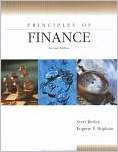| |||||
• polskie
• Zamów informacje o nowościach z wybranego tematu • kontakt |
PRINCIPLES OF FINANCEBESLEY S., BRIGHAM E.wydawnictwo: SW, 2003, wydanie IIcena netto: Principles of Finance 2nd
Edition Description: The first course in finance for finance and business majors has traditionally focused solely on managerial (or corporate) finance. Now, many schools are indicating a need to introduce these students - particularly the non-finance business majors - to the other two major components of finance - institutions and investments - in this first course but at the same level of rigor as traditional financial management texts. With Principles of Finance, Second Edition, Scott Besley and Gene Brigham begin with a discussion of the principles of financial systems and business organizations, move on to valuation concepts and corporate decision making (managerial finance). They conclude with coverage of investment fundamentals. Key chapters may be covered in a one-term course or supplemented with cases and outside readings for a two-term course. Chapters are written in a flexible, modular format, allowing instructors to cover the material in their favorite sequence. Benefits: CFO Salaries Included: Chapter 1, "An Overview of Finance" includes new vignettes with salaries of CFOs in large and small companies. Includes Stock Prices Declining: Real-world examples used in Part V (Investment Decision Making) help students to understand the risk that is associated with investing. Revised Chapter 13, "Capital Budgeting": Was Chapter 9 in the first edition. Discussion of relevant cash flows has been moved to the beginning of the chapter to show how cash flows associated with capital budgeting projects are determined, which helps them better understand the application of the capital budgeting analysis techniques. Discussion of risk and capital budgeting has been streamlined. Condensed Chapter 15 on Working Capital Management: Chapter 15 (Ch 12 in first edition) has been condensed because most students study inventory management techniques in management information systems courses. Also, to be consistent with the concept of valuation that is discussed throughout the text, the technique for analyzing proposed changes in credit policies has been changed from a "heuristic" approach to an NPV analysis. Financial Analysis and Planning moved up: Chapter 8, "Financial Planning and Control," was Chapter 14. The chapter was moved along with Analysis of Financial Statements to provide an understanding of general financial analysis and budgeting before more complex analyses, such as risk and valuation. The explanations, especially those about "additional funds needed" (AFN) have been simplified. The discussions relating to leverage and breakeven analysis have been simplified also. Early explanations of how financial markets operate: Knowing how security prices are determined helps one to understand how managerial finance affects the value of the firm thus providing background needed for coverage of such key concepts as risk analysis, time value, and valuation techniques. New Chapter 5, "The Cost of Money (Interest Rates)": Contains an expanded (and better) discussion of interest rates, factors that affect interest rates, forecasting interest rates, and how interest rates are determined in the financial markets. 2002 Tax Rates Included: Chapter 6, "Business Organizations and the Tax Environment," includes 2002 tax rates in the appendix. New organization of Analysis of Financial Statements and Financial Forecasting: Moved to Part II (Chapters 7 and 8, respectively). This placement helps students "ease" into the more complicated material that follows in Part III (that is, time value of money, valuation, and risk and return concepts). Time Value of Money (TVM) discussion and problems have been moved to the appendix of the chapter (Chapter 9): Because financial calculators have made interest table obsolete, this placement eliminates some of the clutter in the chapter. Cost of Capital now precedes Capital Budgeting (in the first edition, the order was reversed): This placement helps link the determination of the cost of capital (Chapter 12) with the valuation of financial assets (Chapter 10). This link helps students understand that investors who provide funds to firms effectively determine the firm's required rate of return (cost of capital). And, this understanding helps students to better grasp the concept of capital budgeting decisions. 720 pages Księgarnia nie działa. Nie odpowiadamy na pytania i nie realizujemy zamówien. Do odwolania !. |


